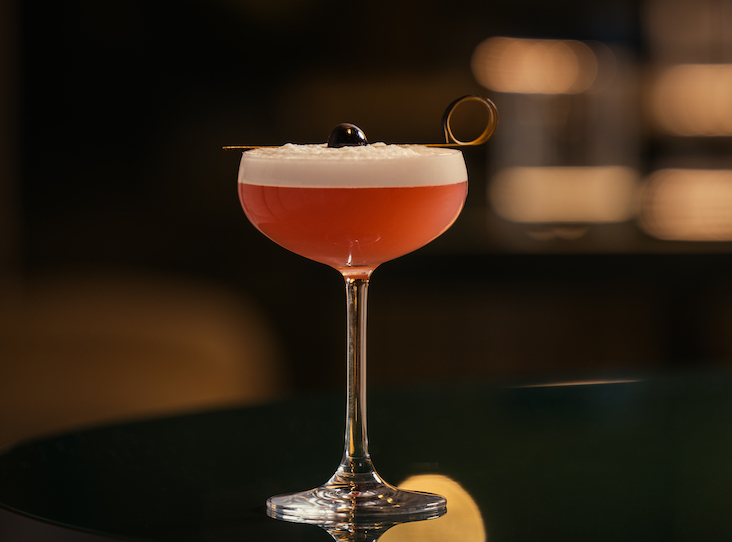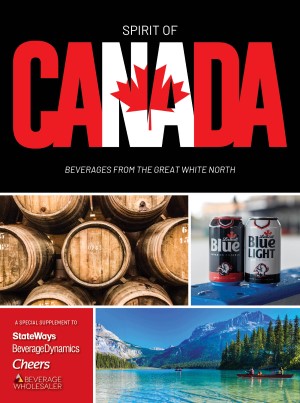The Flavor of Vodka
Hot new flavors and a backbar full of super and ultra premiums are turbo-charging the vodka business.
By Nicolas Furlotte
Flavored vodka is fast-becoming the next big thing and a wave of new, mostly ultra premium entries is seemingly competing to see which can boast the highest price, the most unique distillation process and the most distinguished heritage.
Meanwhile, at the country’s trend-setting bars and restaurants and hottest night spots, the “cosmopolitan” is the latest in a seemingly endless series of sophisticated drinks that is helping propel vodka to new heights. Consumer appetite for martinis and other classic cocktails continues to grow along with an as yet unquenchable thirst for vodka, which has been the dominant distilled spirits category for more than 25 years. Today, vodka accounts for about one of every four bottles of liquor consumed in the U.S. and the category continues to gain share each year.
Ketel One, which helped pioneer the ultra premium vodka segment, is currently introducing “Citroen,” a citrus-flavored line extension.
About 10 years ago, flavored vodkas began making a slight impression on consumers but the pace of flavored introductions has picked up markedly over the past 18 months and additional line extensions and new flavors are expected to be rolled out later this year. Similarly, the ultra premium segment was of little consequence as recently as three or four years ago. Over the past couple of years, however, the upper end of the vodka market has become crowded with an increasing number of new entries. Today, while the total of flavored vodkas and ultra premiums still accounts for less volume than the category’s best-selling brand, Smirnoff, it’s where many suppliers are focusing their attention for two simple reasons: Flavors are increasingly in demand from consumers, and super and ultra premiums are exceptionally profitable.
Over the past decade or so, the category’s definitions have also evolved. At one time Smirnoff was considered the top of the line, only to be replaced by Stolichnaya and then much more convincingly by Absolut. Today, Smirnoff is essentially a “standard premium” with super premiums Absolut, Stoli and Finlandia generally priced above that, Ketel One slightly higher, and brands such as Belvedere, Chopin, Grey Goose and others constituting the ultra premium segment priced the highest.
Many, but not all, of the new super and ultra premiums, as well as the flavored line extensions, are imported. And imports’ share of the vodka category has been steadily increasing. Last year, imports accounted for 19%, or almost one of every five bottles of vodka sold in the U.S., up from 17.7% the previous year. According to Adams Handbook Advance, the first annual publication to detail full-year 1999 beverage alcohol consumption, last year was one of the few in which the total volume of imports (more than 6.4 million cases) eclipsed that of category leader Smirnoff (more than 6.2 million cases). Smirnoff, by the way, has taken to proclaiming its “triple distilled” process and earlier this year introduced a sleek, more contemporary-looking package.
One of the hottest vodkas in the country, Skyy recently introduced its first flavor, “Citrus.” Skyy’s provocative ads and sponsorship of film festivals and other events has helped position it as the vodka of choice for trendy downtown denziens. Or is that aspiring uptown sophisticates?
A booming economy, of course, has provided a solid underpinning for much of the category’s high-end expansion, while the flavor craze has been embraced across a wide spectrum of food and beverage categories.
Teresa Zepeda, brand director for Skyy vodka predicts that the next few years will continue to be especially rewarding “for brands that can offer more than just liquid — in terms of image and quality.” In fact, for high-image “badge” brands, annual price increases that translate to about $1 per bottle have not been uncommon.
Skyy has been one of the distilled spirits industry’s true new product success stories of the past decade. During the past few years, in particular, the brand’s positioning and marketing have been enhanced and sharpened while its growth rate, currently close to 20% a year, shows no sign of slowing. Its first line extension, Skyy Citrus, a 70-proof flavored vodka was recently introduced.
The hottest new flavored vodka, introduced about a year ago, is Absolut Mandrin, which has quickly established itself as the #2-selling imported flavored vodka in the country. Mandrin is second only to its sister brand, Absolut Citron. Together, these two Absolut flavors had combined sales of about 700,000 cases last year, according to Adams Handbook Advance, with Citron up about 13% over the prior year.
Recently introduced Vox is distilled five times. Imported from the Netherlands it is available in a striking, column-shaped bottle made from Austrian glass.
According to Jim Schleifer, Seagram Americas’ marketing director for Absolut, part of the reason for Mandrin’s appeal is that “the orange flavor system is not an acquired taste.” And that simple fact, coupled with the huge initial success of Mandrin, is helping to spur new citrus-flavored entries in the vodka category. Overall, citrus — lemon, lime, orange and grapefruit — are among the most popular soft drinks flavors as well. So, for the most part, beverage alcohol marketers are going with established consumer taste preferences rather than attempting to create something outside the realm of tradition or lead consumers to a smaller flavor niche.
That’s why, in the rum category, Bacardi came out with its hugely successful Limon. And that’s why, in the ultra premium vodka segment, Ketel One has just launched “Citroen” and Grey Goose is introducing “Vodka L’Orange” this June.
“Our surveys show that flavored vodkas are consumed for the most part with a neutral mixer like tonic or Sprite or else on the rocks,” explains Bill Thompson, vice president, brand development at Sidney Frank Importing, the marketer of Grey Goose. “There is a small amount of orange (flavored vodka) that is going into cosmopolitans, but by and large, the reason the flavor is being bought is because it is being consumed with soda water and it provides that little bit of flavor people are looking for in a drink without dousing it in orange juice.”
Absolut set the standard for super premiums and is far and away the leading imported vodka. It is also the second best-selling brand of vodka, imported or domestic. Absolut launched the flavor craze with Citron and has re-ignited the segment with Mandrin, which it introduced last year.
Amid the surge in flavored vodkas, there are some interesting non-citrus niches. Finlandia Cranberry, for example, occupies one such space. Brown-Forman, which took over marketing responsibilities for Finlandia in 1996, repackaged and relaunched Finlandia Cranberry last September. Since then, according to brand manager John Vidal, sales are up more than five-fold. “A lot of that support is from on-premise,” he says. “Because of its unique color, Finlandia Cranberry is perfect for cosmopolitans.”
During the six-months ending this past February, combined sales of Cranberry and the base brand were up 55% over the same period in the prior year. Vidal says that a strong economy and “the martini craze, which has made it to the inner regions of the country and is now a 50 state phenomenon” are the real drivers of the vodka category’s sustained growth and prosperity. Finlandia is considering the possible introduction of a new flavor later this year.
Repackaged, refocused and relaunched, Finlandia is showing double-digit growth. Both the base brand and the cranberry-flavored expression are doing well and a new flavor will likely be introduced later this year.
“We hope to have additional flavors that make sense for the brand and proprietary flavors and packaging that stay within the character of the brand,” Vidal says. That means that rather than a single flavor such as a raspberry or an orange, for example, Finlandia would look more to a fruit combination such as strawberry/kiwi or a medley of different melons.
Beyond flavors, vodka’s vitality is also evident in two new ultra premium entries: Vox and Thor’s Hammer.
Introduced in March of this year, Vox is an 80-proof vodka that is created from 100% wheat and distilled five times. “Vox combines the 400-year-old distillation expertise of the Netherlands, a country with a long legacy of excellent vodka, and meticulous distillation techniques,” says Nancy Lintner, vice president of marketing, Jim Beam Brands. Vox is packaged in a distinctive, column-shaped bottle.
Although not one of the first into the ultra premium segment, Grey Goose has emerged as one of the leaders. It is currently rolling out its first flavored entry, “Vodka L’Orange.”
Thor’s Hammer, meanwhile, represents the most aggressive new product launch ever by Barton Brands. Slated for introduction this June, Thor’s Hammer is targeted primarily at 25- to 35-year-old urban, upscale, high-income males. Priced in the $25 to $28 range for a cork-finished 750 ml at retail, Thor’s Hammer is an 80-proof, wheat-based vodka imported from Sweden. The brand’s imagery draws heavily on Nordic mythology and one of its principal points of product differentiation is “a unique taste, mouthfeel and consistency” that is a result of its distillation process and “a water source dating back to the ice age.”
“Unlike some other imported vodkas that taste harsh or a little thin, especially on ice, here’s a product that holds up on ice,” says Ed Gualtieri, vice president of marketing at Barton Brands. “I think upscale guys are going to flock to this vodka.”
Thor’s Hammer, aimed at upscale, ubran men, represents Barton Brands biggest new product launch. Imported from Sweden and boasting an “ice age” water source and rich mouthfeel, a 750 ml cork-finished bottle of Thor’s Hammer will retail for about $25 to $28.
Less than 10 years ago, when Ketel One seemed like Sisyphus trying to roll a container of ultra premium vodka up a hill, the proliferation of luxury vodkas and flavors seemed unimaginable to most. Today, however, Ketel One has sales of more than 580,000 cases (up 29% last year) and the super and ultra premium segment has enormous momentum.
As Barton’s Ed Gualtieri says, “Today, consumers can’t seem to get enough of quality, imported vodkas, and whether it’s the standard version or a flavored version, lots of them are doing well.




